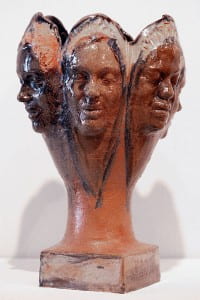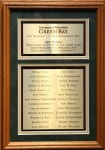 At groundbreaking for the Creative Communication complex in October 1971, Green Bay Mayor Don Tilleman, Prof. Coryl Crandall, academic dean John Beaton and Conny Nelson were on hand for the occasion. If Crandall’s grin is particularly pronounced, it might be because of the ceremonial “face pot.” Creative arts faculty members convinced campus administrators that it was traditional to create a glazed pot with human imagery to hold some of the dirt, in order to bring good luck to the future building and its occupants. Some of the conspirators confessed years later that there was no such superstition… until they made it up for the CCC groundbreaking.
At groundbreaking for the Creative Communication complex in October 1971, Green Bay Mayor Don Tilleman, Prof. Coryl Crandall, academic dean John Beaton and Conny Nelson were on hand for the occasion. If Crandall’s grin is particularly pronounced, it might be because of the ceremonial “face pot.” Creative arts faculty members convinced campus administrators that it was traditional to create a glazed pot with human imagery to hold some of the dirt, in order to bring good luck to the future building and its occupants. Some of the conspirators confessed years later that there was no such superstition… until they made it up for the CCC groundbreaking.
Naming of the 1965 Room
 In May 1985, UW-Green Bay opened and dedicated the private dining room in the student union known as the 1965 Room, which has since become a popular venue for meetings and planning retreats. The room’s naming reflects the year of the University’s founding, when Gov. Warren Knowles signed enabling legislation authorizing a four-year institution for Northeast Wisconsin. A plaque displayed just outside the door honors 26 men and women — local business people, city, county and state officials, representatives of UW System Administration and others “had made bringing a campus to Green Bay their top priority.”
In May 1985, UW-Green Bay opened and dedicated the private dining room in the student union known as the 1965 Room, which has since become a popular venue for meetings and planning retreats. The room’s naming reflects the year of the University’s founding, when Gov. Warren Knowles signed enabling legislation authorizing a four-year institution for Northeast Wisconsin. A plaque displayed just outside the door honors 26 men and women — local business people, city, county and state officials, representatives of UW System Administration and others “had made bringing a campus to Green Bay their top priority.”
Adult ‘auditors’
In 1972, the new UW-Green Bay welcomed its first guest auditors, men and women ages 60 and older, who were invited to register for courses (in which there was extra capacity) and sit in free of charge, except for any fees for materials. The program was popular and a way for campus to connect with community members. The first venture of its kind in the UW System, it was soon picked up by other campuses including UW-Madison. The “auditors” program was curtailed sharply when high enrollments and budget cuts began to chafe in the early 1990s. Arguably, the decades-long popularity of the program set the stage for the success of the Learning in Retirement program.
Farmhouse office
Founding Chancellor Ed Weidner and staff operated out of the old Maloney farmhouse (since razed, located near the present-day soccer field) when the University began to develop the Shorewood campus in 1967.
Radical fears
A 1969 door-to-door student survey of 750 Green Bay-area residents found a majority (53% to 36%) worried about the era’s campus radicalism. Respondents said they suspected the new UWGB would bring ‘trouble’: marches, anti-war demonstrations, mobs, militants, drugs, partying and ‘dirty art.’
The Fourth Estate
The name was adopted in fall 1969 from the European-born term for the press as a fourth power joining the clergy, nobility and commoners. The weekly student newspaper carried news from all four UW-Green Bay campuses including the feeders in Manitowoc, Marinette and Menasha.
TV was early, often
The new UW-Green Bay was widely considered ahead of its time in embracing the relatively new medium of television as an education tool. State-of-the-art production facilities were part of the design for the Instruction Services Building, one of the first three new campus buildings (along with the Laboratory Sciences and Environmental Sciences buildings) to open on the Shorewood site in 1969. Some of the programming was aimed at children (including this 1980s production with actors in woodland animal costumes), while most was more serious stuff, aimed at adult learners. UWGB made history in October 1970 by inaugurating a live, closed-circuit TV hookup of the course Man and his Social Environment, transmitted from the Instructional Services Building studios to Marinette. It was a higher-ed first in Wisconsin. (More on the photo above: It was taken during production of a program titled “Little Bear” featuring professional actors. “Little Bear” was produced in 1985 and was created as a tool to teach children about issues of child sexual abuse. An accompanying program for teachers was completed in October of that year and distributed to schools throughout Wisconsin and beyond.
‘Bay Badgers’
UW-Green Bay was founded as a sister campus to the UW in Madison and used a water-skiing “Bay Badger” as its sports mascot in 1969-70, before declaring independence with the Phoenix in May 1970.
Weidner’s sixth sense
At groundbreaking for the first three buildings on Nov. 3, 1967 on windblown, barren farm fields, Chancellor Ed Weidner spoke briefly and gestured to the open spaces and said, simply, “I don’t know if you can see the buildings out there, but I can.”
Signing Day
Republican Gov. Warren Knowles signed legislation authorizing a four-year university for Northeast Wisconsin on Sept. 2, 1965. The pen and a copy of the document are framed and displayed in the 1965 Room of the University Union.









